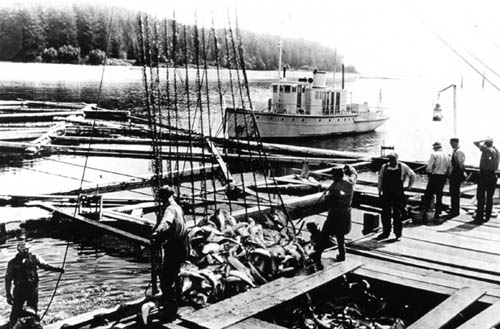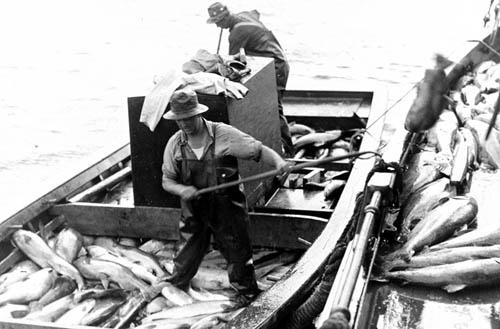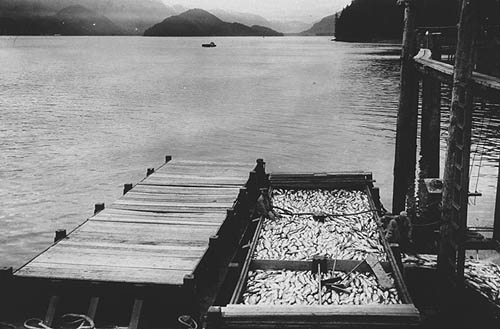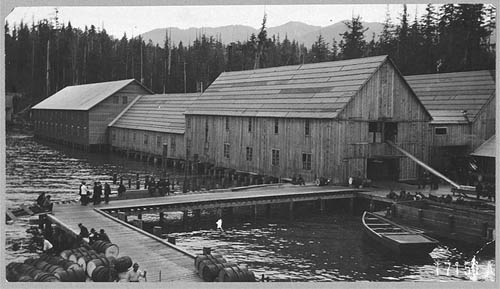 Ketchikan's Real Melodrama! By June Allen August 30, 2002
 Southeast Alaska - Click on photo to view a larger photo - Historic Photo Courtesy of the U.S. Fish & Wildlife - Fisheries Collection - Photographer: Archival photograph by Mr. Sean Linehan, NOS, NGS A browse through the Internet searching for fish pirate sites brings up hundreds of them, most being New Age Green Peace locations dealing with present-day "illegal, unreported and unregulated fishing." The tenor of the Green Peace sites could be summed up from the intro to one of them, "If you buy fish in a store, do you know where it comes from? It might be stolen from the poor. It could have cost lives." Ketchikan's historical story of fish piracy, however, is along far different lines, because - whether it was right or wrong - fish traps were quite legal at the time even if fish piracy wasn't. Hollywood has willed us a mental picture of a pirate - a gold hoop earring, a bandanna holding back ebony curls framing a handsome face, perhaps a red-striped shirt over tight black pants, a gleaming sword in one hand. Ketchikan's fish pirates, however, looked much different! A Ketchikan fish pirate's ensemble included sagging dark wool pants over rubber boots, a shabby dark sweater and a dark wool watch cap pulled low over his forehead. He also carried wet burlap bags to drape over the letters identifying his craft fore and aft. If he was handsome, you wouldn't know it until he got back to town for a shower and shave. He was just like anyone else, maybe had a wife and family in a small house on stilts on the saltwater west end of Ketchikan and his life's savings in his boat. And he had a hard time making a living because he couldn't compete with the canneries' fish traps! He didn't rob corsairs for their gold, but he did rob fish traps for their silver cargo - salmon.  Southeast Alaska: Salmon being transferred to a large boat on which they are iced and hauled to a cannery. - Click on photo to view a larger photo - Historic Photo Courtesy of the U.S. Fish & Wildlife - Fisheries Collection - Photographer: Archival photograph by Mr. Sean Linehan, NOS, NGS Fish traps. They've been legally banned since 1960, immediately following Alaska Statehood in 1959 - except for the four traps allowed the Indian reservation of Metlakatla, which are not regularly used, in the interests of conservation. In fact, the United States was the last nation in the world to outlaw fish traps. Alaska's 20th century traps caught salmon in great numbers - if they were in the right place at the right time, which they most often were. They eventually threatened the survival of the species. Cultures around the world from the earliest times used some sort of trap to catch fish. Stakes were driven along the outer edge of tide pools in South Pacific islands, for instance, to trap the fish during outgoing tides. Britain's early Celts devised weirs to trap spawning Atlantic salmon. Other ingenious devices were devised for every ocean, bay and river location since the dawn of man. In 20th century Alaska, anadromous salmon were at first caught in fairly efficient stationary traps situated at the mouths of spawning streams. After 1906, no such "fixed" trap was allowed in Alaska's waters. It took Ketchikan's own J.R. Heckman (1865-1939) to envision and create a "floating" fish trap that could be placed offshore, away from the mouths of streams. The year of his invention is different in various accounts. But 1910 seems to be a safe year to nail down at least the design and construction if not the first uses of the Heckman device. Nova Scotia-born James Robert Heckman, who preferred to be called "Bob," was a well-known and well-liked member and one of the founders of the early Ketchikan community. At the time he invented the floating fish trap he was in his 40s, completely familiar with salmon fishing and processing. He had become the foreman of the Loring cannery in 1890, when he was only 24. He remained in that post for 30 years, until 1920. By the turn of the century Heckman made his home in Ketchikan, commuting back and forth to Loring. In 1912, he started his own Pure Foods Cannery on the Spruce Mill dock. In addition, he was owner of J.R. Heckman Co., owning the Heckman businesses in about half the block bordered by Front, Mission, Dock and Main Streets. And he was a longtime president of the Miners & Merchants Bank. What was it he invented, this floating fish trap? It was a huge wire net contraption under floating logs of immense dimensions, the trap held in place in its annual, seasonal destination by trap anchors of gigantic size and weight. There are trap anchors on display in several places in the Ketchikan area and there are a couple underwater, securing docks on Pennock Island, maybe on Gravina too. From this anchored and floating log rectangle hung underwater curtains of wired net. One was a length that, when placed in the path of known migration routes of salmon, detoured the fish along its length and through a narrow funnel into the wire-net-encircled "entrapment" part of the device. The fish could not escape from this but they swam without injury until they were brailed out - scooped and dumped into scows by cannery tenders to be towed directly to the cannery for processing. The traps became part of the cannery operation, either owned directly by the packer or by individuals.  Southeast Alaska: This barge-load of salmon attests to why the Alaska salmon fishery was the most valuable fishery prosecuted by U.S. fishermen at the time of this photo. - Click on photo to view a larger photo - Historic Photo Courtesy of the U.S. Fish & Wildlife - Fisheries Collection - Photographer: Archival photograph by Mr. Sean Linehan, NOS, NGS Trap-caught salmon were fresh and bright and brought good prices in the marketplaces down south, and there were a lot of salmon out there waiting to be caught - or so it seemed at the time. In addition, the traps meant new wireworks businesses, bringing workers and dollars into the Ketchikan's tax base and economy. It also meant increased logger activity in providing the trap logs, as well as sawmill work for fish boxes, pallets, tierces and other needs. More and more canneries located in the Ketchikan region. The canneries and their management and workers needed supplies - from blankets to rain gear to cigars and fresh foodstuffs, bringing prosperity to Ketchikan's merchants. It was the canneries supplied by fish traps that made Ketchikan the Canned Salmon Capital of the World! And as a "big city" as Southeast Alaska communities went in those days, it brought in halibut fleets for provisions and repair, amenities of technology, and entertainment, as well as wide-eyed tourists! But one thing was overlooked
in all this frenetic activity: It was hard for an individual,
independent fisherman to make a living! How could he compete
with the traps! His traditionally caught-and-delivered fish were
not as fresh as the trap fish when delivered to the cannery and
brought a lower price. And there was no way the local salmon
fleets could hope to match the sheer harvest volume of the trap
fish. Such situations bring resentment and with it, retaliation!
Bribery was big. Picture a floating fish trap in August in the middle of nowhere or so it seemed, nothing to see except waves or whitecaps and maybe a passing vessel in the distance. Even in the protected waters of the Inside Passage, a good blow might come along and rock this trap like a cradle. On the trap was built a small deck occupied by a tiny shack for the lonely trap watchman. This shack contained a cot, a shelf, foodstuffs and maybe a small table. The canneries often hired older high school or college students. There was no radio then, no television, no cell phones - not much to do except to battle seasickness.  Salmon cannery about twenty miles south of Ketchikan, in the Tongass National Forest - Click on photo to view a larger photo - Forms part of: Frank and Frances Carpenter collection (Library of Congress). Gift: Mrs. W. Chapin Huntington; 1951. Historic Photo Courtesy of the Library of Congress Prints and Photographs Division - Washington, D.C. Some of the traps were brailed out six days a week, others less often. It was a boring, lonely life. So picture a fisherman heartily hailing from a seiner, offering money to the watchman to look away for a bit. It was a moral dilemma for the watchman. The trap held thousands of fish; would it hurt if an honest fisherman brailed out a few hundred for himself? There were always more where those came from. This became such a common practice that the canneries hired patrols to keep watch on the watchmen. The patrols were not immune to a little bribery themselves, so the canneries hired Pinkerton men (from a national detective agency) to cruise the patrols that spied on the watchmen who were supposed to keep the fish pirates away! There were other clever methods to commit trap theft and any oldtimer can tell you his own favorite fish pirate story. The moral implications of the practice are immortalized in playwright Bob Kinerk's "Fish Pirate's Daughter." But all good - or bad - times must come to an end. The 1920s were the peak of all that fishery activity, although it continued much longer. By 1929, the peak year, there were those who saw the handwriting on the wall - the salmon bounty couldn't last forever. J.R. Heckman himself is reported (by an angry fisherman, now resting in Bayview Cemetery) to have warned that year, "Well, boys, we got 'em all." By 1939, the year Heckman died, that forecast proved accurate. The heyday of the salmon fishery was in decline and was never again the same. Four years before Heckman's death, the issue of fish traps came before the Congress of the United States. There was a move afoot to ban fish traps in American waters. Fishermen testified as did fishery biologists. But the cannery lobby prevailed. It wasn't until Alaska Statehood in 1959 that one of the first acts of the new State of Alaska was to ban fish traps forever! Under Alaska Fish & Game management, the resource is coming back. All's well that ends well.
|